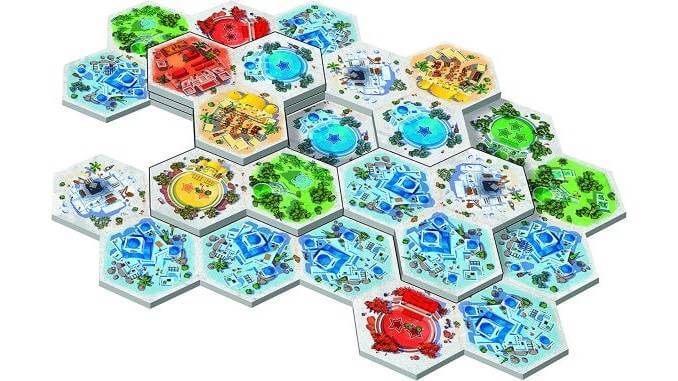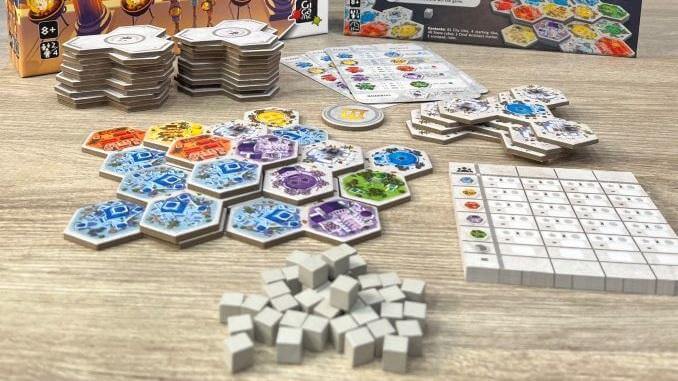Akropolis is a tile-laying game with very simple rules, but the way you place and score the tiles gives the game its heft as well as its potential for conflict with fellow players. It’s surprisingly quick to play, but don’t let that or the colorful art hide the game’s spiteful heart.
Akropolis appears to recycle a very tired theme (ancient Greece—you could substitute Egypt or Mesopotamia and the same applies), but it’s an abstract game where the theme is mostly irrelevant. You’re drafting tiles that comprise three hexagonal spaces and placing them in your city, either adjacent to what you’ve already placed or on top of existing tiles. Building upwards gains you points, although you lose anything you’ve covered up in the process. When the game ends, you count up the hexes you can see (birds-eye view) and multiply the relevant total by the number of stars in that color, getting five subtotals you’ll add together for your final score.
The first part of the game is tile-drafting; each round starts with four tiles in a line in the market, plus a stack of tiles for the next round. The one farthest from the stack is free for the active player to take; each tile closer towards the stack costs one more stone for the active player to take. The tile-drafting aspect of the game is fairly easy to manage, but you do have to ensure you don’t end up without any stones—it’s more like something everyone has to learn, and then once all players have figured this out, it isn’t a big part of the game going forward.
Each hex space on a tile can have one of six colors. The plain gray color isn’t worth any points, but can get you one stone when you cover it with another tile, so setting up areas of two to three grey hexes that you can easily cover later with another tile is also a core strategy. The other colors each score in a unique way. Blue hexes score for each hex in the largest contiguous stretch of blues. Yellow hexes score if they aren’t touching another yellow when the game ends. Purples score if they’re surrounded by other hexes. Reds score if they’re on the exterior edge of your city. Greens score no matter what. A hex is worth one point per level, so one on the table is worth one point, one on the second tier is worth two points, and so on.

The five colors only score if you also have hexes showing those same colors with stars on them, which form the multipliers that you use to determine the score for each color. These star hexes are rarer than the “regular” kind, so grabbing at least one of each is essential to winning. (I suppose it’s possible to win while punting one whole color, but in my experience it seems unlikely.) You score a color by adding up the points along the rules I outlined above and then multiplying that by the number of stars in that color.
The game ends when you’ve used up all of the tiles but one—it’s 37 for a two-player game, 49 for a three-player game, and all 61 tiles for a four-player game. By that point, each player should have a city with at least a tile or two on the third level, and hopefully at least one star hex for each of the five colors.
The crux of Akropolis’ strategy comes from the scarcity of the star hexes. They’re quite limited, with the green stars the rarest of the colors, with just three such tiles in the two-player game, and those have three stars apiece on them. If one player gets all three, they get nine points per green hex in their city, and their opponent gets nothing for greens. But even if one player gets two of the three stars, they get six points per green hex and their opponent just half that. Other stars might not be as scarce, but getting the right combination of hexes and matching stars—and perhaps taking a tile or two that your opponent might need to do the same—is the core of Akropolis strategy, and what gives this game a sneaky take-that element.
The entire game plays in a half hour or less—I’d guess you could get a 15 to 20 minute two-player game if both players know the game already. Turns are extremely quick, and often there’s a clearly obvious “best” tile on the market. That also means that the luck of the tile draw has a substantial impact on who wins the game. There are enough tiles in total that it’s not the only determining factor, but it’s definitely part of it. If you don’t use the take-that aspect, you could easily play this with kids as young as seven or eight, but Akropolis is probably best played with a little bit of spite.
Keith Law is the author of The Inside Game and Smart Baseball and a senior baseball writer for The Athletic. You can find his personal blog the dish, covering games, literature, and more, at meadowparty.com/blog.

